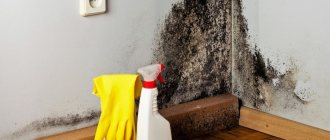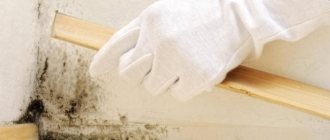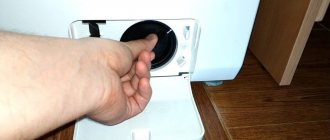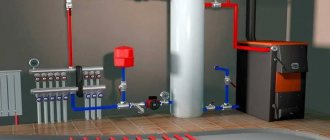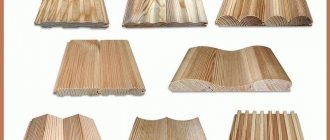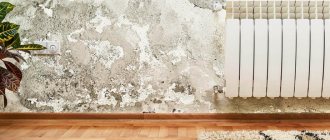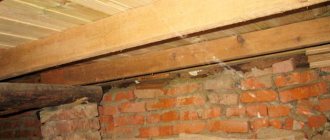The underground is the space under the house between the ceiling of the first floor and the surface of the ground. It is usually entered from the premises (unlike basements, which may have entrance doors from the street). In subfloors there are often no windows; the floors and walls remain earthen, reinforced with boards. The “ceiling” of the subfloor is the floors of the first floor of the house.
Another difference is the height (the distance between the ground surface and the ceiling of the first floor). For crawl spaces it can be 130-170 cm or even less, while basements usually have higher ceilings (170-230 cm).
This space is used for laying communications, and less often - for storing something (usually food). It is characterized by stagnant air and constant dampness, which is an excellent habitat for mold fungus.
How to remove mold from wood
By attacking wood, mold spoils its aesthetic appearance. But the main danger of the fungus is not damage to property, but its negative impact on the human body. Spores can provoke an allergic reaction and even cause mycotic pathologies. If the damage is minor, you can remove mold from wood yourself, using antiseptics or improvised means.
Kinds
The type of mold determines the choice of method that will help you effectively deal with it forever.
Black
Black mold is the most active and fastest growing of all. It usually destroys the surface quickly. There are several strains that cannot be distinguished from each other without special research.
It is very dangerous for humans, as if it enters the body it causes poisoning and allergies. Fighting black mold is quite difficult - it is not susceptible to most folk and chemical preparations.
Xin
Blue is not so dangerous for the human body, but it causes destruction of structures. Affects fresh and old wood, leading to its rotting. Particularly dangerous for load-bearing structures.
Putrefactive fungus
Putrefactive fungus spreads under conditions of high humidity in the room and the presence of external sources of moisture. Antiseptics and home methods can cope with it.
See also
How and with what you can dye your trousers blue with your own hands at home
White
White mold affects not only furniture, but also food. It is easy to deal with, since it is not resistant to aggressive drugs. It does not pose any significant danger to the body.
Causes of mold formation on wood
Before looking at how to remove mold from wood, it is important to find out why it appears. The first sign that there is fungus in the house is a change in color. A characteristic brown, blue, black, pink or white color appears on the surface of the wood. At first the spots are barely visible. And in the absence of timely treatment, they increase in size and affect large areas of the material.
Some bacteria do not destroy the texture and do not penetrate deep into the wood. But they can ruin the aesthetic appearance of wood trim, floorboards or wall cladding. There are several reasons why fungus appears on wood:
- improperly organized ventilation in the room;
- high humidity;
- sudden temperature changes;
- condensate;
- low-quality wooden material;
- infection of wood by fungi;
- contact with damp soil for a long time.
Mold fungus is dangerous not only because it multiplies quickly, but also because it has a negative impact on people and pets. If you use material contaminated with mold to build or decorate a house, the consequences can be very serious, including the complete dismantling of wooden structures.
Types of fungus
If fungus occurs in the house, not everyone knows its consequences and how to deal with it. And at the same time, any type of fungus is very dangerous for wood products. They contribute to the destruction of wood fibers. As a result, if harmful formations are not eliminated in a timely manner, a house made of wood may completely collapse to the very foundation. Fungal spores can spread through the air or be carried on clothing or animal fur.
Important! In ancient times, buildings infected with this kind of pest were burned to protect other buildings from being affected by this “disease.”
White house mushroom
It contributes to the destruction of the wood structure, changes in its color and the appearance of cracks.
Blue fungi
When such formations appear, the wood acquires a gray-blue tint. Bacteria destroy varnish and paint. Thus, moisture gets inside the products.
Rotting fungi
There are wet and dry rot:
- Wet damages damp wood that is near the ground or drainpipes. Affected products become loose and dark lines form on them.
- Dry, in turn, manifests itself as reddish dust in the corners and multiplies quickly in a humid environment. Gray stripes appear on the tree, destroying the wood fibers.
White and black mold
This type of microorganisms can form not only on wooden surfaces. Stone, concrete tiles and various fabrics can become a place for the emergence and active reproduction of fungus. In addition to its destructive effect on various materials, mold is very harmful to human and animal health. Therefore, if a fungus appears in the house, its consequences and how to deal with it still need to be clarified, and as quickly as possible.
Step-by-step removal of mold in wooden products
Elimination of consequences and prevention of further proliferation of fungal spores is carried out in several stages. How to remove mold from a wooden surface if the problem is found in a neglected state:
- Cleaning damaged areas. You will need a spatula and a chisel. Remove the top layers with a spatula. A chisel and knife are used if damage to the internal structure of the wood is detected.
- Dispose of all removed wood. It is advisable to burn all cut layers of wood.
- Washing the material. Prepare a concentrated solution of laundry soap and carefully treat cleaned wooden surfaces.
- After treatment with soapy water, the wood is allowed to dry. Then they are treated with a wood antiseptic. After disinfection, the wood is allowed to dry and the treatment of problem areas is repeated.
Important! You need to apply an antiseptic not only to areas damaged by mold, but also to areas around it. There may be spores scattered there that have not yet had time to manifest themselves.
How to clean boards from mold
There are two ways to clean boards from mold: call a specialized service that specializes in removing infected areas or get rid of the fungus yourself. If large-scale wood damage is detected, it is better to use the services of specialists. Since such companies determine the type of disputes and select the most effective means of destruction. In addition, processing is carried out with professional equipment.
If you decide to remove the fungus yourself, a person will need to prepare tools for the work and disinfectants that destroy mold spores.
How to get rid of mold on a wooden surface
If the material is only slightly affected, the following will help get rid of mold:
- chisel and spatula;
- sandpaper;
- hammer;
- soft rags and fine sandpaper.
The scale of mechanical intervention depends on the depth of penetration of fungal spores. Sometimes it is enough to remove the thin top layer and then perform disinfection without severe damage to the timber.
Antiseptic
A properly selected chemical solution will destroy mold growth areas. As a rule, universal antiseptics and active fungicides are used for these purposes. The following have proven themselves well in the fight against disputes:
Important! Any chosen anti-mold product is used strictly according to the instructions. In addition to the recommended dosage, it is important to pay attention to the optimal temperatures at which processing is performed.
These antiseptics do not contain dangerous chlorine compounds and volatile toxins. At the same time, they are capable of not only destroying areas of bacterial growth, but also subsequently protecting the wood from spores. In addition, there are solutions that additionally have a toning effect. This allows the lumber to retain its natural appearance.
Folk remedies
Before treating the timber against fungus and mold using professional means, you can try traditional methods of combating it. Such means were successfully used for control even before special chemical solutions appeared on the construction market. Among the most popular are the following:
Industrial bleaches
Domestic and foreign industry today produces many effective and affordable products that can be used to whiten a log or timber house.
According to experts, one of the best bleaches is the Russian drug “Sagus”, which is used to prevent the formation of corrosion, and also effectively treats wood from fungus and whitens the surface.
Sagus not only lightens the wood, wood bleached with the product acquires an even shade, and black spots and spots disappear from it. The composition is resistant to weather conditions and humidity, so it can be used both inside and outside the house.
Another domestic product that is used to bleach wood is Neomid 500. It rids wood of fungus and mold, evens out the color, and also protects it from insects. For deep lesions, a concentrated composition is used. If there are only small pockets of fungus on the tree, the composition is diluted with water in a 1:1 ratio.
How to prevent mold
After disinfection, it is important to take preventive measures. This will not only destroy all mold, but also prevent its occurrence in the future. The rules of prevention are not complicated and consist of the following steps:
- ensuring good air circulation;
- eliminating sources of high humidity. If the house has a basement, regular ventilation and heating will be required;
- maintaining stable temperature;
- annual treatment of wooden facades and finishing with a special antiseptic.
Private wooden houses are most susceptible to mold. Therefore, it is important to avoid mistakes when arranging ventilation, waterproofing and insulation. Since even with modern antiseptics, it is very difficult to completely remove mold. It is much easier to prevent it from appearing.
Source: tvjam.ru
Ways to “treat” damaged lumber
The first way to save wooden building material is to treat it with antiseptic solutions before darkening occurs.
When asked what to do if the boards become moldy, blue or blackened, there is only one answer: immediate treatment.
The algorithm of actions is as follows:
- Wood bleach treatment. Let's say the timber has darkened by 3-4 centimeters, this can be seen in the cross section. Bleach will help here, penetrating up to 5 centimeters deep.
- Treatment with an antiseptic agent that prevents the development of bacteria in the body of the board.
Reasons for appearance
The main reason for the appearance of bluish spots on wood is the spread of fungal mold. The fungus uses wood as a nutrient medium, damaging the fiber structure, causing cracks and other defects.
Risk factors for wood stain
- Storing or using wood in rooms with insufficient air circulation and high humidity. Such environmental factors are most favorable for the spread of mold spores affecting a large surface area.
Important! Fungal spores develop at a temperature of 5 °C and wood moisture content of more than 18%.
- Prolonged contact of a wooden surface with soil, grass, water and other substances containing fungal spores.
- Unfair processing of wooden surfaces. Boards and logs with rough edges, bark and knots are more prone to blue staining than smoothly processed lumber.
- Lack of sun. Areas of wood that are constantly in the shade become infected with fungus and turn blue first.
- Violation of transportation conditions - long stay of lumber in closed containers, non-compliance with storage rules.
- In some cases, blue discoloration may occur on a tree that is still growing. Areas eaten up by beetles, bark beetles, and weevils become especially vulnerable to mold fungi.
Prevention methods
The set of preventive measures will take less time than treating a simple fungus at home. Problems are easier to prevent, so it is important to ensure their ventilation in a bathhouse or wooden house.
Hydro- and vapor barrier
The main reason for the formation of pathogenic microorganisms is excessive humidity levels and the influence of steam. It is important to protect furniture and structures from this. Therefore, it is imperative to use special varnishes that protect the wood.
In a room where the humidity is always exceeded due to objective factors, for example, in a bathhouse, it is necessary to ensure a pleasant microclimate and regular ventilation.
Roof and foundation integrity
Before putting the house into operation, the roof and foundation must be covered with paints, varnishes and antiseptics. The appearance of fungus in these structures is not always noticeable, but as a result they grow and cause harm. Cleaning and application occur only on a clean surface; brushes, sprayers and rollers are used.
Vapor barrier membrane for protection against condensation
A vapor barrier membrane will protect against condensation and serve as an additional measure. The event is presented as a whole.
Why is it dangerous?
Fungal infections penetrate the wood to a relatively small depth - up to 2 mm. At the first stages, the strength of lumber does not change. It can be used for construction or repair work. But the mold-affected area will absorb more moisture, which means the processes of fiber destruction will occur more and more intensely.
What are the risks of using wood with blue stains?
- the erected structure becomes unstable and loses strength;
- products made from such wood can deform in a short time;
- the aesthetic appearance and presentability of the tree is lost, an unpleasant musty smell appears;
- a residential building made from affected lumber becomes hazardous to health - mold provokes joint pain, allergic reactions, and lung diseases.
Important! There is a so-called internal blue stain, when the outer layer of raw wood is dried, and a fungal infection has already appeared in the inner layers.
Content:
- Causes of fungus
- Types and signs of fungal formations
- How to remove and destroy
- How to destroy fungus step by step
- How to prevent mold from reoccurring
- Video on how to get rid of fungus in the underground of a wooden house
If the eternal struggle between humanity and mold has transferred its battlefield to your wooden house, then there is no time to hesitate.
The first signal that cannot be missed is the appearance of dark green, whitish, gray and black spots, after which particularly sensitive people will notice the smell, and over time it will only intensify. Many people do not attach any importance to the appearance of mold in the house, and even the smell does not bother them. And since the basement is usually characterized by a cool temperature, food is stored there without a twinge of conscience. Although science has already proven that fungus in a wooden house causes allergies and has a destructive effect (even on the space station they encountered its harmful effects).
If there is a fungus in the underground of your wooden house, then in this article we will look at the most effective methods on how to get rid of it.
Remedies for blue discoloration
To destroy blue stains and prevent its further appearance on the material, it is necessary to take a radical approach - eradicate the fungus from the deep layers of wood.
Special bleaches, impregnations and antiseptics help get rid of unsightly blue spots. They can be purchased at construction markets, or you can prepare them yourself.
Home Remedies
- Chlorine. Dilute regular chlorine bleach (“Whiteness”) with water in a 1:1 ratio. Treat the entire surface area with the resulting composition, and then rinse it with plenty of water. Dry the wood thoroughly and make sure that there is no efflorescence left on it. Clean off any efflorescence that appears and then apply the finishing coat.
Important! The disadvantage of chlorine is that the substance is aggressive and can make the structure of the wood more loose.
- Oxygen bleach powder. Dilute the product in warm water until completely dissolved, place the resulting solution in a spray bottle or garden pump. Spray the liquid on the wood for an hour, without allowing the previous layer to dry. Remove stubborn mold with a stiff brush. Rinse treated areas with clean water and dry.
- Bleaching powder. Add 2 kg of bleach and 250 g of soda to a bucket of water. Mix the mixture and let it sit. Drain the water and treat the wood with the resulting slurry using a brush or roller.
Factory means
“Bioshield” is a wood bleach with antiseptic properties. Effectively removes fungi that cause blue and blackening of the surface, destroys fungal spores and putrid blackness. Suitable for processing all types of lumber. If the lesions have spread deep into the wood, the product is used as an impregnation - applied to the surface several times with an interval of 1-2 hours.
“Neomid 500” is a concentrated bleach with a regenerating effect. Quickly copes with fungi that cause significant changes in the color of wood. Returns the tree an attractive appearance without changing its characteristics and properties. Can be used in its original or diluted form.
“Prosept 50” is a fast-acting chlorine bleach for wood. The result of the drug will be noticeable within 30 minutes after treatment. The active substance penetrates into the deep layers of lumber without changing its natural properties. The product contains no dangerous additives, which allows it to be used even for impregnating wooden surfaces that come into contact with food.
The fight against blue stains on wood should begin at the logging stage. Proper storage and transportation of the material will help protect it from fungus and preserve its beneficial properties. If mold does appear, it should be destroyed as soon as possible, using proven means.
Source: dvabrevna.ru
Bleaching blackened wood
In the warm season, from May to October, wood is easily affected by wood-staining fungi. They do not cause any particular damage to the tree, but the presentation is lost because the wood turns blue and black. In addition, blue color creates a breeding ground for wood-decaying fungi. The color of wood exposed to open space also changes under the influence of ultraviolet radiation, first acquiring a yellowish tint, gradually turning into a dirty gray. The problem of mushroom stains can arise in sawmilling, during the storage of sawlogs and lumber, during the construction process, as well as in a constructed wooden house.
It’s especially offensive for the owner of a newly built house - a black log house is not at all pleasing to the eye. You can combat this sad fact in several ways: paint, sheathe it with other material (for example, siding), sand or trim off unsightly stains and, finally, use chemical bleaching, which will be discussed. Bleaching can be used both in primary wood processing and in wooden house construction, carpentry and furniture production, as well as in the pulp and paper industry. The natural color of the wood is restored, and the structure is completely preserved. However, it should be taken into account that lumber, which will subsequently be subjected to further processing, can only be bleached superficially; during planing and profiling, colors may again appear on its surface. Another thing is a wooden house. It will look like new. In furniture production, bleaching is used to give the surface of wood a lighter color, even out the color of the core and sapwood, and remove stains. Pulp bleaching is a complex chemical process carried out using a variety of chemicals and processing equipment under high temperatures and pressure.
What types of wood bleaches are there?
Conventionally, bleaching chemicals can be divided into two groups: those containing chlorine and those not containing it. The first include sodium and potassium hypochlorite, bleach, chlorine dioxide. The second includes various salts and alkalis in combination with hydrogen peroxide, oxalic acid, acetic acid, ammonia, ozone.
Active oxygen-based bleaches work great on aged wood, but are less effective against staining fungi. They do not have an unpleasant odor (if they do not contain ammonia), do not require thorough rinsing with water after treatment, but their working solution is viable for a short period of time.
Chlorine-containing bleaches are very effective, but have a strong odor, they must be washed off with water, and it is quite difficult to control the completeness of the wash.
In addition to the main components, the bleach contains substances such as stabilizers that slow down the decomposition of bleaching components, fungicidal additives, agents that improve the penetration of the solution into the wood, catalysts, thickeners and surfactants (detergents). Fungicidal additives serve to protect against fungi and mold after bleaching; agents and catalysts do not themselves participate in bleaching, but help the bleaching agent penetrate the pigments. Thickeners allow you to apply a larger layer of bleaching composition to the surface of the affected wood, and surfactants help wash away contaminants.
How is wood bleached?
Wood before treatment Wood after treatment with SENEZH compounds
When wood is treated with bleaches, the pigment bonds of lignin become discolored due to the destruction of chromophore groups and discoloration of the cells of wood-coloring fungi.
When is wood bleaching necessary?
In wooden house construction, the need for bleaching may arise as a result of improper storage of the material, in warm and humid weather, or in conditions of unventilated timber.
It is impossible to plan damage to wood; it can occur at any time during construction. It is advisable to carry out bleaching immediately after detecting that the wood has been painted in an uncharacteristic color.
The need to bleach lumber usually arises for two reasons: damage to the lumber stock and damage to the lumber.
In the first case, it is possible to determine the need for bleach, but in the case of lumber, it is impossible to plan for such a need; it arises as the problem is identified.
Both builders and lumber manufacturers are among the most common users of bleach. This is sometimes explained by purely economic considerations, because the cost of blue-affected lumber is $80 per 1 m, and the cost of high-quality lumber reaches 250 euros per 1 m. However, in the case of lumber processing, it must be remembered that after planing the fact of bleaching will be obvious, since the impact of chemicals is less deep to whiten the wood throughout its entire thickness, and is about 2 mm.
Another thing is the treatment of finished products with bleach, for example, rounded logs or joinery. The need for bleaching arises if you need to cover them with transparent compounds, lighten the overall background or remove stains. The requirements for the surface of joinery products are high, therefore the bleaching composition should not destroy the structure of the wood or impair adhesion, and the action of the composition should be gentle in order to preserve the natural pattern.
What is required from wood bleaches?
Bleaching agents used in sawmilling, home construction and carpentry must have certain necessary properties. The composition should not destroy wood. Should be easy to prepare and apply.
Of course, the natural color of the wood must be preserved. Necessary properties also include maintaining the possibility of applying tinting coatings, adhesives and transport, as well as preservative antiseptics after bleaching. The bleach must be safe.
It should be taken into account that bleaching is not a protective measure and the affected wood, after restoration of its natural color, can be again affected by wood-staining fungi.
Therefore, it is recommended to treat bleached wood with an antiseptic solution.
How to remove mold, mildew and insects from wooden surfaces
How to remove mold, mildew and insects from wood? This question is often asked by people when they want to preserve the aesthetic qualities of lining, timber, or picket fence. The modern paint and varnish market is replete with all kinds of compounds to prevent the destructive effects of aggressive natural factors on lumber.
However, you should understand that by purchasing an antiseptic for wood against moisture and rot, you will not be able to eliminate existing damage, destruction, or blue stains. Such products can provide effective prevention and act on wood like complex vitamins on the human body, increasing immunity and strengthening the structure. But a good wood antiseptic against mold and mildew will kill wood-boring beetles.
Which antiseptic to buy to remove mold from wood
The appearance of mold on a tree is already a disease, and it requires adequate treatment. Here you need an antibiotic bleach, which is a cheap chlorine-based NEOMID 500. It is chlorine that has bleaching properties.

